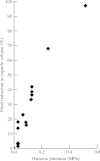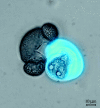Water relations of the pine exine
- PMID: 15897205
- PMCID: PMC4246869
- DOI: 10.1093/aob/mci169
Water relations of the pine exine
Abstract
Background and aims: Water adhesion forces, water absorption capacity and permeability of the pine exine were investigated to consider a possible function of sporopollenin coatings in the control of water transport.
Methods: The experiments were carried out with sporopollenin capsules obtained from pine pollen consisting of an empty central capsule and two sacci. Changes in the concentration of excluded dextran molecules in the medium were analysed to quantify water absorption by purified exine fragments and the osmotic volume flow out of the intact central capsule.
Key results: The contact angle of sporopollenin to water is higher than the one to ethanol and lower than the one to n-heptane. The water-filled pore space in pine sporopollenin amounts to only 20.6 % of the matrix volume. A monosaccharide was excluded from 15 % and a trisaccharide from about 38 % of this space. Shrinkage of the central capsule induced by permeable osmotica was transient, whereas that induced by sodium polyacrylate (2100 g mol(-1)) was stable. Values obtained for the hydraulic conductance L(P) of the exine (0.39-0.48 microm s(-1) MPa(-1)) are comparable in size to those of biomembranes. Sodium sulfate solutions induced a significant osmotic flow through the exine (reflection coefficient at least 0.6). The exine around the central capsule can be ruptured by equilibration of its lumen with a concentrated electrolyte solution and subsequent transfer to water. The denatured protoplast along with the intact intine was ejected when pollen grains were subjected to this osmotic shock treatment.
Conclusions: The pine exine is easily wetted with water and does not represent a significant barrier to water exchange either liquid or gaseous. Through osmotic burst, it can be separated from the intine. The effect of salts and small solute molecules on water fluxes may be functionally significant for rehydration upon pollination.
Figures








References
-
- Ahlers F, Bubert H, Steuernagel S, Wiermann R. 2000. The nature of oxygen in sporopollenin from the pollen of Typha angustifolia L. Zeitschrift für Naturforschung 55c: 129–136. - PubMed
-
- Aylor DE. 2003. Rate of dehydration of corn (Zea mays L.) pollen in the air. Journal of Experimental Botany 54: 2307–2312. - PubMed
-
- Ducker SC, Pettitt JM, Knox RB. 1978. Biology of Australian seagrasses: pollen development and submarine pollination in Amphibolis antarctica and Thalassodendron ciliatum (Cymodoceaceae). Australian Journal of Botany 26: 265–285.
-
- Ehwald R, Sammler P, Göring H. 1973. Different affinities of the α- and β-anomers of D-glucose, D-mannose and D-xylose for the glucose uptake system of Baker's yeast. Folia Microbiologica 18: 102–177. - PubMed

